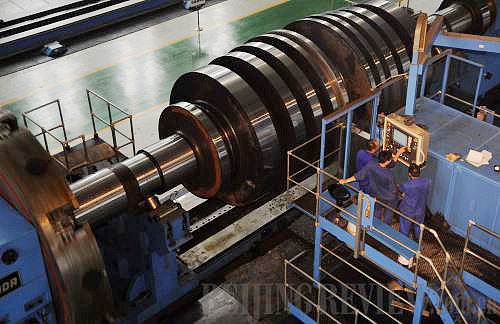|
 |
|
ROARING REFORM: Pictured is a plant of the China National Erzhong Group Co., a central SOE that manufactures heavy machinery (LI QIAOQIAO) |
For research and management employees of China's central SOEs, salaries and bonuses remain a major source of income. The dividend incentive reform could offer a chance for the backbone staff on important positions to increase their income, said Wu Yanhua, chief accountant of China Aerospace Science and Technology Corp. Wu is one of the designers of Star Space's reform program.
"This move is set to make the capable workers richer," said Wu. "The benefit is it can help motivate the employees, beef up system reform of central SOEs, and contribute to indigenous innovation of the enterprises."
In addition, it will help the enterprises with sustainable development and enhance their ability to translate technologies into tangible economic benefits, he said.
But, the reform is not without suspicions. Worries have abounded companies may use the reform to recklessly boost remunerations for top-level executives. Many even fret the dividend incentive program may provide an umbrella for unscrupulous executives to seize state assets.
But the SASAC downplayed the concerns. Since the pilot program lasts three years, any enterprise that fails to meet SASAC's performance requirements during the period will be forced out of the program, said the SASAC.
Equity incentive
Shao said the SASAC will gradually expand the pilot program to cover more enterprises, and even explore equity incentives when the timing is appropriate.
"We decided to push forward dividend incentive first because the situation of central SOEs is complicated," he said. "It would take a lot of courage for the enterprises to break the system barrier and establish a new income distribution mechanism."
Equity incentive still faces some doubts in China, he said.
"Especially equity incentive of non-listed SOEs has to deal with some sensitive issues, such as how to price the transferred shares," Shao said. "We had even made experiments with equity incentive, but the reform aroused suspicions. That is why we have returned to the safer dividend incentive."
Shao said enterprises have reached a consensus about dividend incentives, and considered it an effective mechanism to stimulate employee productivity.
In 2006, the SASAC explored the possibility of equity incentives, but stopped two years later. That was due to two major reasons, said Lu Ming, an analyst with the Equity Incentive Research Center of the Beijing H&J Consulting Co. Ltd.
In 2008, the Chinese economy received a heavy blow from the global financial crisis, depressing share prices of many SOEs and eliminating the viability of equity incentives, said Lu. According to rules of the China Securities Regulatory Commission, the prices of incentive equity should not be lower than the closing share price in the trading day before the release of the company's equity incentive program, or the average closing price in 30 trading days before the release of the program.
Moreover, the equity incentive became a target among critics because of increased payments for SOE executives at a time of economic slowdown and reduced corporate profits, he said.
"The dividend is a positive sign that the central SOEs are already moving toward system reform," he said. "Besides, success of dividend incentive can also set a good example for equity incentive."
Consolidation efforts
In addition to dividend incentives, China is also consolidating central SOEs. The goal is to foster a string of world-class competitive enterprises during the 12th Five-Year Plan (2011-15), said Shao.
In recent years, the SASAC has placed greater emphasis to quality than quantity of the central SOEs. Many smaller, weaker enterprises have been merged with larger and stronger ones.
Shao said there is the need to explore multiple ways to precipitate reorganization, such as mergers and acquisitions (M&As) and stake replacement.
"After completing M&As, the enterprises need to integrate the resources and sharpen their core competitiveness," he said. "The key is to adjust their business structure and spin off those non-core or non-strategic businesses."
"In the past few years, the central SOEs focused on spin-off of less profitable investments," said Shao. "But what is more important is to withdraw from businesses that are not in line with the company's long-term development strategy, even though they are profitable."
China's central SOEs are mostly engaged in a wide range of fields. A central SOE's non-core assets might be urgently needed by other ones, so it is necessary to reorganize and consolidate these enterprises, he said.
SASAC data show fixed assets investments of Chinese central SOEs totaled nearly 10 trillion yuan ($1.5 trillion) during the 2006-10 period. In addition, more than 40 central SOEs have so far listed their main businesses on the stock markets. | 